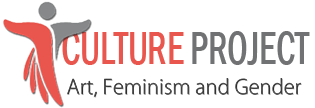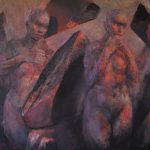3,103 Total views, 3 Views today
Scott Douglas Jacobsen: Your corpus is large, so this particular interview cannot cover it. But I am open to doing a series in the future. Nonetheless, I want to cover some of your general style and work and recent productions. Let us start like the beginning of a superhero origin story.
Your work focuses on the human being as a whole. The person as an identity, as a mind, as a body, as feelings, as sensations, and so on. Why focus on the body as a whole? Why not focus on a part of it, or another object and set of things altogether?
Nurettin Erkan:Thanks for your compliment. This is a pertinent question regarding all my paintings. It has many reasons and so many answers. Much as space and its objects are situated in a particular time and place, they are also representatives of power.
Given this situatedness of objects, if one uses objects, eluding this temporal and spatial belonging, and reaching a universal essence might be difficult, even impossible. I need to reach its free condition. And this freedom is equipped with resistance, not with objects. This resistance is what I am interested in.
My paintings are paintings of resistance. This is my first response but it is even more complex and wide. Thematizing the body is a philosophical position as well as a plastic-aestethical alignment. The body has been undermined throughout time. They are active fields of resistance, deep assimilations, and of speechlessness.
Violent practices on mind are not quite convenient and fruitful; the state knows that. Hence in state prisons, body torturers rather than mental torturers are on task. States are bloody-minded and armed. No one inflicts self-censorship on one’s cultural and/or political production process or on manner of resistance under the threat of verbal insult.
One can however silence herself as a result of assaults on her body. When individual subjects begin to resist—even affording the violence on their own bodies—the state takes more formidable measures by calculating this probability.
And this means violating the bodies close to these individuals, which works to end the latter’s possibility of individual freedom of thought and movement. It is precisely the reason why, during wars, states implement violence on the body as a weapon.
Close relatives, ethically or religiously related individuals, women and children are thus on the state’s target. Behind the limitlessness of imprisoning the teacher Ayşe lies the state’s desire to exhibit its disciplinary stick over the bodies of a woman and a baby. It is an act to silence the voice of the society and break its resistance.
The state as a symptom of masculinity is characterized by constructing and protecting itself, and sacralizes this self-construction. For that reason, it never tells the truth to its citizens, especially to the women.
One who discovers the truth finds out about the state’s dirty works and becomes the reason for the latter’s dissolution. States comprise men as public enemy with their hands getting around the public’s body.
This body purged of space also attains a genuine time belonging to herself. Is not a human being in conflict with her time? Who does not feel isolated towards everything, even towards her own body?
When alone, when looking at your naked condition in the mirror, you see, what stands there is your body resisting to belong to a time. You see your body striving to overcome all the challenges of time, its agelessness, its weight, its pain, its emotion…Then you wear your twenty first century pants and shirt in order to go out.
My paintings, therefore, are not nude, nor naked because their skin is not the one seen under a fabric. They are paintings identified more with rocks, trying to structure towards an “I” further back in time.
Jacobsen:Where did the talent for art begin for you?
Erkan:It is the shared story of all the children who did not speak Turkish. I did not speak Turkish when I started school, and it is a common situation among the many Kurdish children in Kurdistan region of Turkey.
We were considered to have no issues with the language we spoke and the language we did not speak. And it is still the same. Nothing has changed in Turkey. On the contrary, as you may well know, it is getting worse. So children who attend school are situated somewhere between the school and the family.
This is in fact the story of isolation. These children become multilingual individuals estranged both from the school and the state its behind, and from the family.
The classes on physical education, music, or painting are the classes these children first build connection because they convey a more intelligible language than the official one. The first language I made contact with was painting.
Painting is my third language—the first two being Kurmanji and Zazaki—which paved the way for me to contact with the outside world. My connection with art thus began, and to be frank, those were the best years of this relationship.
Jacobsen:You have focused on women and time based on Leonardo Da Vinci. What was the inspiration from Leonardo Da Vinci? How did this relate to time and women?

Erkan:Da Vinci is one of the painters who have particularly influenced me. He is a classical Renaissance painter but to me he is also the one who painted the best surrealist paintings in art history. He said much more than was told to us which we do not know much about. Technically, I was first inspired by Da Vinci’s hues.
I was perplexed when I first saw “Virgin of the Rocks” in London. The hues he used to depict human skin was absolutely something else not limited to human skin. It was not even human skin. Concepts were flying over my head for this skin tone. I was interested in the discussions around double gender in his figures.
When I first saw “Mona Lisa,” I strived to look the man behind her without being influenced by the rumors. It was honestly difficult; the crowd at Louvre did not allow for a comfortable view. Yet, it is enough for Mona Lisa to momentarily glance at you to not forget her.
There are similar gendered discussions on “The Last Supper” as well. Lately, I have been trying to spend time with it. As you know, it is singularly composed of men: Jesus and his apostles. I concur with symbolically situating this patriarchal structure in this painting at the historical moment when patriarchy will eventually be dissolved.
I have thus thought about painting a counter painting. There are reworkings of “The Last Supper” in popular culture, however, we cannot really talk about a serious version. I have completed a version comprising only women. I have a couple of reasons for that. It is obvious what masculinity has brought into this world.
And history has her own dynamics constructing the end of masculinity. Nazi Germany has wounded the world built upon a man’s sickness.
I decided to paint “The Last Supper” in order to refer to today’s artistic soul as well as to the role of the Kurdish women.
Jacobsen:What was the presentation of “Image and the Body” in the Istanbul, Turkey about in 2016?
Erkan:The exhibition “Image and the Body” was a special group exhibition selected among the Bora Collection. I was in fact later informed about the exhibition as I was in the US during the exhibition process.
I have paintings in the collection of Summart Art Organization, and they also exhibited a selection of my paintings. It included artists thematizing the body. That is unfortunately all I know.
Jacobsen:What do you view as the ultimate nature of the human?
Erkan:Human’s primitive nature is obvious but I will presume what you have in my with “the ultimate nature” is the nature of our dreams and desires. For this reason, we may perhaps not call it nature but a dream, a utopia.
We are endeavoring to build equality, equality between women and men, between races, between nature and nurture, between all values of our world. In one of his novels, Milan Kundera writes: “woman is the future of man.” 
I believe Kundera is considering all of humanity beyond the individual self: future will be built by the womanhood. And I believe in it. We men are not the future of anything. If we are going to construct another nature, it is absolutely going to be a female nature.
Feminine nature of the Rojava Revolution is therefore promising for the world. Indifference or even hostility of the global world towards the Rojava Revolution emerge from this reality. It is a revolution headed by women which started with a serious awakening that disrupts the capital. Our ultimate nature must therefore be women.
Jacobsen:What epitomizes the struggle of the human being, e.g., the assertion of the self in the ocean of the world?
Erkan:The struggle itself epitomizes the human being and her life. A human being who does not resist against power and its oppressions cannot be defined and might be considered as a human without being. Our selfis either surrounded or in resistance.
I think that consciousness of a self is the beginning of resistance, and reflects itself on the body. As I mentioned before, the body is the field of resistance, and every kind of struggle to build justice, equality, and freedom finds its substance in the body.
Jacobsen:What do you consider your best metaphorical representation of the self?
Erkan:The body. I consider a little detail and movement of the body as a clue for the self; therefore, paintings on the body are the paintings that carry the deepest traces of the human being. Among the painters that significantly influences me is Lucien Freud, and his paintings also exemplify my point.
Jacobsen:Any final feelings or thoughts in conclusion based on the conversation today?
Erkan:I do not. Thank you for the interview.
Jacobsen:Thank you for the opportunity and your time, Nurettin.
About the artist:
Nurettin Erkan was born in Turkish Kurdistan in 1965. He completed his primary education in various cities in Kurdistan, Mimar Sinan Fine Arts University (aka “Istanbul Academy of Fine Arts”), graduating in 1993. Erkan has exhibited his paintings in Belgium, Czech Republic, Greece, England, France, Moldovia, and US. His works appear in notable collections; his articles and interviews have been published in numerous newspapers and magazines. He currently lives and works in Madison, Wisconsin.






